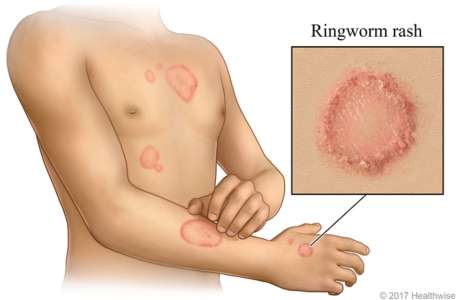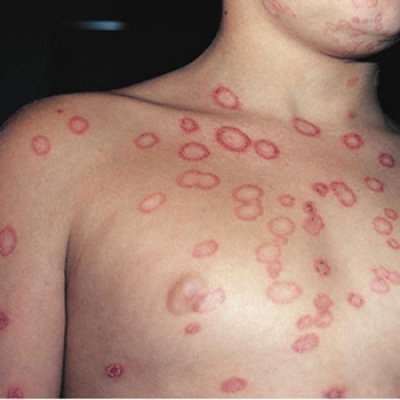Title: Ringworm: Signs, Symptoms, Causes, Risk Factors, Diagnosis, Prevention, Diet, Lifestyle, and Homoeopathic Treatment
Introduction:
Ringworm, despite its name, is not caused by a worm but rather by a fungal infection. It can affect the skin, scalp, and nails, leading to discomfort and skin lesions. Understanding the signs, symptoms, causes, risk factors, diagnosis methods, prevention strategies, diet and lifestyle considerations, and the potential role of homoeopathic treatment is essential for effectively managing ringworm. In this blog post, we will explore the key aspects of ringworm and its holistic approach to treatment.
Signs and Symptoms of Ringworm:
1. Red, itchy, and scaly patches: Circular or ring-shaped patches on the skin with raised edges and clear centers.
2. Pruritus: Intense itching and discomfort in the affected areas.
3. Skin lesions: Blister-like bumps, pustules, or open sores may be present.
4. Hair loss (in scalp ringworm): Bald patches or broken hairs on the scalp.
5. Nail changes (in nail ringworm): Thickened, discolored, or brittle nails.
Common Causes of Ringworm:
Ringworm is caused by various types of fungi known as dermatophytes. These fungi thrive in warm and moist environments and can be transmitted through direct contact with an infected person, animal, or contaminated surfaces.
Risk Factors for Ringworm:
1. Close contact: Sharing personal items like clothing, towels, or combs with an infected person.
2. Poor hygiene: Inadequate cleanliness and failure to maintain proper hygiene practices.
3. Warm and humid environments: Excessive sweating or living in environments conducive to fungal growth.
4. Weakened immune system: Individuals with compromised immune systems are more susceptible to fungal infections.
Diagnosis of Ringworm:
Ringworm can be diagnosed through various methods, including:
1. Visual examination: A healthcare professional may identify the characteristic appearance of ringworm lesions.
2. Wood's lamp examination: A special ultraviolet light can help detect certain types of fungi under the skin.
3. Skin scraping: A sample of the affected skin may be taken and examined under a microscope or cultured in a laboratory to identify the specific fungus.
Prevention Strategies, Diet, and Lifestyle Considerations:
1. Personal hygiene: Maintain good personal hygiene practices, such as regular handwashing, using clean towels and clothing, and avoiding sharing personal items.
2. Keep the skin dry: Moisture-wicking fabrics and ensuring proper ventilation can help prevent fungal growth.
3. Avoid barefoot walking: Wear sandals or shoes in public places, especially in locker rooms, swimming pools, and communal showers.
4. Regularly clean and disinfect: Clean surfaces and items that may come into contact with fungi, such as gym equipment or shared combs.
5. Avoid contact with infected individuals or animals: Be cautious when in close contact with individuals or pets with known ringworm infections.
Diet and Lifestyle:
1. Maintain a healthy diet: Include foods rich in vitamins, minerals, and antioxidants to support overall immune health.
2. Boost immune function: Adequate sleep, regular exercise, and stress management can help strengthen the immune system.
3. Wear loose-fitting clothing: Opt for breathable fabrics that allow air circulation to prevent excessive sweating.
Homoeopathic Treatment for Ringworm:
Homoeopathic treatment for ringworm aims to address the underlying fungal infection, relieve symptoms, and promote healing. Some commonly used homoeopathic remedies for ringworm include:
1. Bacillinum: Indicated for ringworm with severe itching and burning.
2. Tellurium: Useful for ringworm with large, raised, and red patches that ooze a sticky fluid.
3. Sepia: Recommended
for ringworm with circular patches and intense itching, worsened by warmth.
It is important to consult a qualified homoeopathic practitioner for an accurate diagnosis and individualized treatment plan based on your specific symptoms and overall health.
Conclusion:
Ringworm is a common fungal infection that can cause discomfort and skin lesions. By understanding the signs, symptoms, causes, risk factors, prevention strategies, diet and lifestyle considerations, and considering homoeopathic treatment as a complementary approach, individuals can effectively manage ringworm and promote healing. Remember to consult healthcare professionals for an accurate diagnosis and to create a comprehensive treatment plan tailored to your specific needs.



Leave a Message